Frame methods
Getting frame data
To just grab the underlying intensity data, you can do
data = frame.get_data(db=False)
As it implies, if you set the db flag to True, it will express
the intensities in terms of decibels. This can help visualize data a little better,
depending on the application.
Plotting frames
There are a variety of options for plotting frames, meant to produce
publication-ready images. The main function is plot().
You may choose what style of axes ticks and labels to use with the parameter
xtype. By default, xtype=fmid expresses the x-axis as the
relative offset from the central frequency.
fr.plot()
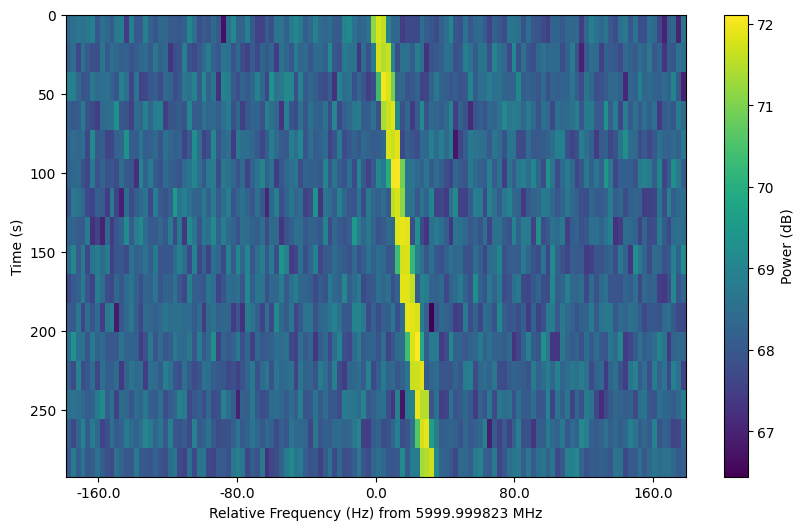
xtype=fmid expresses the x-axis as the relative offset from the
minimum frequency. In addition, we can disable the dB scaling of the
colorbar and turn on minor ticks:
fr.plot(xtype="fmin", db=False, minor_ticks=True)
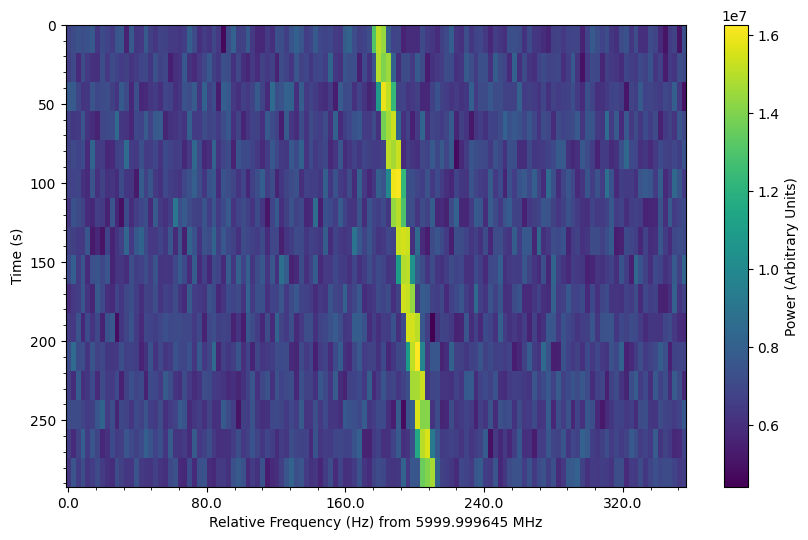
xtype=f expresses the x-axis as absolute frequencies in MHz.
In addition, we can turn on a grid:
fr.plot(xtype="f", grid=True)
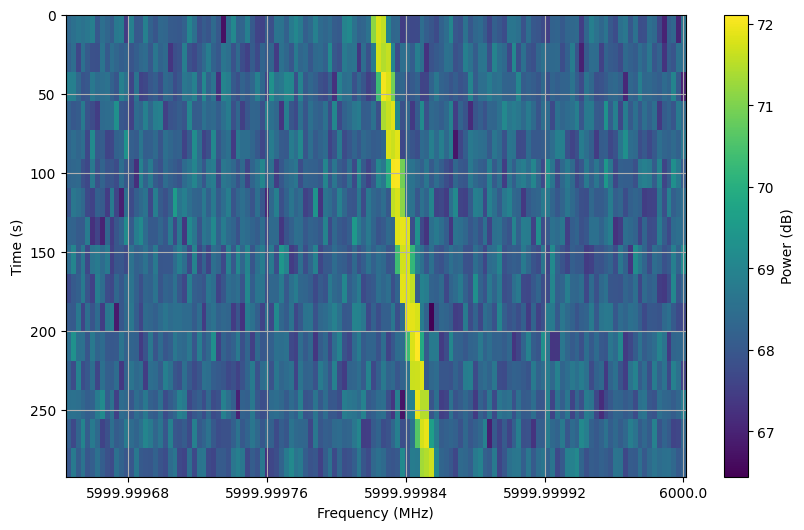
Finally, xtype=px expresses both axes in terms of pixels.
fr.plot(xtype="fmin", db=False)
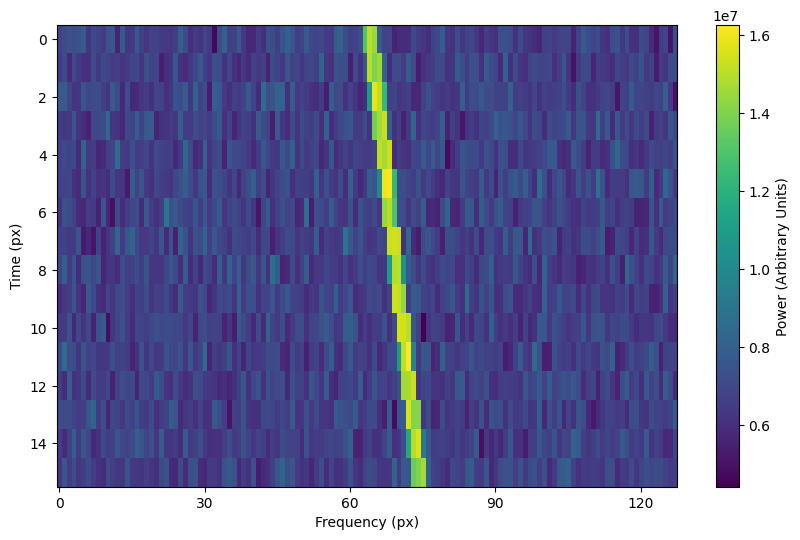
Note that these plots are created using the corresponding units, so that you can
actually plot over them in an intuitive way. For example, we can overplot a
line following the path of our synthetic signals (frame attribute ts_ext
is a time array of length tchans + 1 that includes the end of the frame):
fr.plot(xtype="fmid", db=True)
plt.plot(fr.ts_ext * drift_rate + fr.get_frequency(index=fr.fchans//2) - fr.fmid,
fr.ts_ext,
c='k')
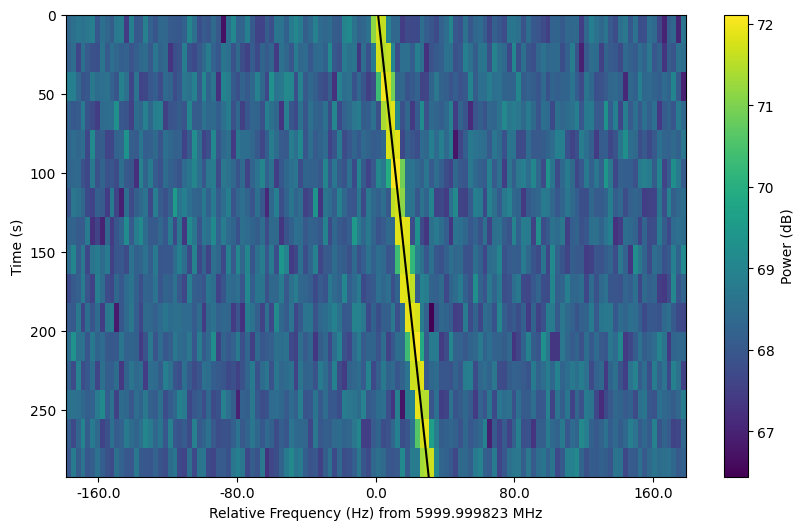
The plotting function uses matplotlib.pyplot.imshow behind
the scenes, which means you can still control plot parameters before and after
these function calls, e.g.
fig = plt.figure(figsize=(10, 6))
frame.plot()
plt.title('My awesome title')
plt.savefig('frame.png')
plt.show()
Frame integration
To time integrate to get a spectrum, or to frequency integrate to get time series
intensities, you can use integrate():
spectrum = frame.integrate() # stg.integrate(frame)
time_series = frame.integrate(axis='f') # or axis=1
This function is a wrapper for setigen.frame_utils.integrate(), with the same parameters. The
axis parameter can be either ‘t’ or 0 to integrate along the time axis, or ‘f’ or
1 to integrate along the frequency axis. The mode parameter can be either ‘mean’ or
‘sum’ to determine the manner of integration.
Frame slicing
Given frequency boundary indices l and r, we can “slice” a frame by using
get_slice(), a wrapper for setigen.frame_utils.get_slice():
s_fr = frame.get_slice(l, r) # stg.get_slice(frame, l, r)
Slicing is analogous to Numpy slicing, e.g. A[l:r], along the frequency axis.
This method returns a new frame with only the sliced data. This is useful when chained
together with boundary detection methods, or simply to isolate sections of a frame
for analysis.
Doppler dedrifting
If you have a frame containing a Doppler drifting signal, you can “dedrift” the frame
using dedrift(), specifying a target drift rate (Hz/s):
dd_fr = stg.dedrift(frame, drift_rate=2)
This returns a new frame with only the dedrifted data; this will be smaller in the frequency dimension depending on the drift rate and frame resolution.
Alternatively, if “drift_rate” is contained in the frame’s metadata
(frame.metadata), the function will automatically dedrift the frame using that
value.
drift_rate = 2
frame.metadata["drift_rate"] = drift_rate
dd_fr = stg.dedrift(frame)